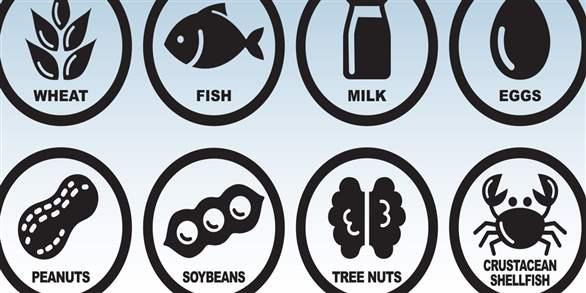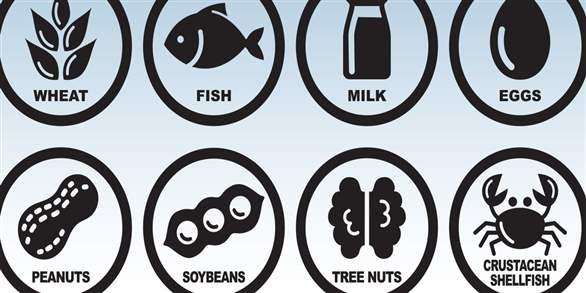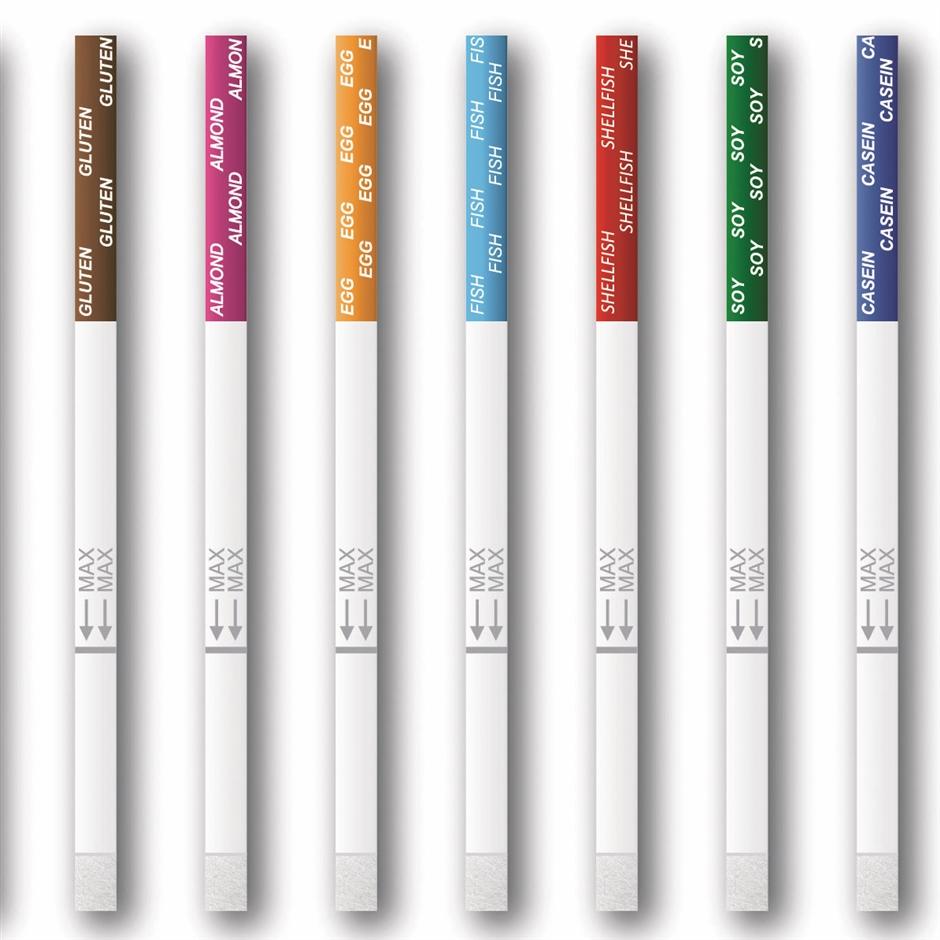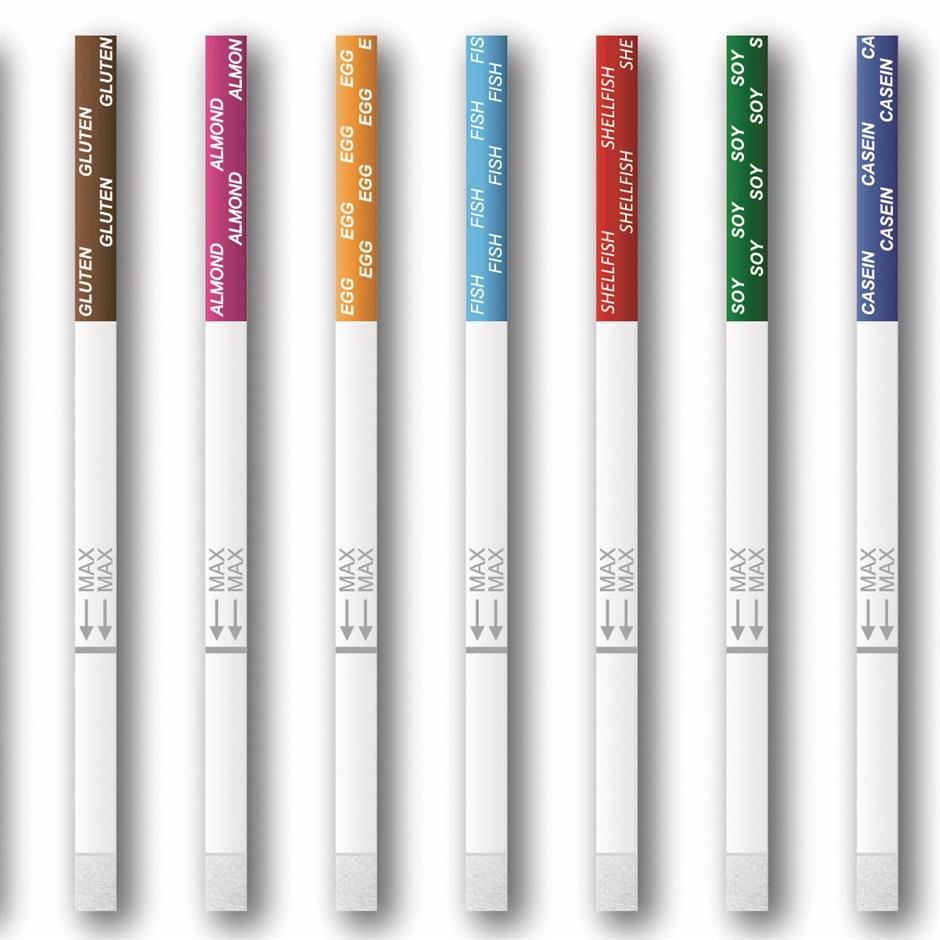Special Considerations for Allergen Testing
FOOD SAFETY AND QUALITY
According to Roman poet and philosopher Titus Lucretius Carus, “what is food to one, is to others bitter poison.” This and other pithy observations were captured in his Latin verse On the Nature of Things. Ancient peoples were aware of adverse reactions to food consumption in certain individuals but lacked understanding of the cause or source. Today, it is widely known that allergens are the cause and sometimes food proteins are the source. There are more than 160 identified food allergens. These are proteins that, when ingested, cause the host’s immune system to react in painful and possibly fatal ways. Allergic reactions to food proteins can include rashes, facial or oral swelling, vomiting, diarrhea, cramps, coughing, dizziness, difficulty breathing, and loss of consciousness. Anaphylaxis, the worst outcome of an immune response, is a severe allergic reaction that can cause constriction of air passages, shock by lowered blood pressure, and suffocation by throat swelling. Anaphylactic shock caused by food allergens is estimated to cause 30,000 emergency room visits and 150 deaths in the United States annually (FDA 2017).
Because of the serious nature of food allergies, the U.S. Food and Drug Administration (FDA) enacted the Food Allergen Labeling and Consumer Protection Act (FALCPA). This legislation defines a major food allergen as a protein derived from either milk, egg, fish, crustacean shellfish, tree nuts, wheat, peanuts, or soybeans (FDA 2006). Known as the Big Eight, these foods make up 90% of all food allergies. The FALCPA requires food manufacturers to label foods containing one or more of the Big Eight and to prevent cross-contact during production. To comply with the FALCPA, food manufacturers must establish standard operating procedures for cleaning and sanitation and preventive controls. Their effectiveness must be monitored regularly.
Detection Methods
Before quantitative allergen detection assays were developed in the 1990s, visual cleanliness was the industry standard for monitoring processing plants dealing with allergenic particulates. The Food Safety Modernization Act does not require analytical testing for allergen detection, but it is strongly encouraged. The analytical methods for detecting allergens are lateral flow devices (LFDs), enzyme-linked immunosorbent assays (ELISAs), quantitative polymerase chain reaction (qPCR), liquid chromatography combined with mass spectrometric detection (LCMS/ MS), and new technologies such as the xMAP food allergen detection assay (xMAP FADA). Each method has positive and negative aspects that should be considered when determining which assay will meet the needs of a monitoring program.
LFDs are qualitative tests that can be used onsite by relatively untrained personnel. As simple antibody assays, they are used to quickly and regularly monitor contact surfaces and rinse waters for allergens of concern. They require no equipment and, when used in conjunction with adenosine triphosphate detection or general protein detection, are a robust tool for evaluating the effectiveness of cleaning and sanitation. However, they do not quantify the allergen.
ELISA is the most popular method used by food processing facilities and third-party analytical labs. Like LFDs, the ELISA technique uses antibodies specific to an allergen. There are qualitative kits that can be used in manufacturing plants, and there are quantitative ELISAs that require a specialized reader to quantify the amount of allergen in the product or swab. ELISA kits are relatively easy to use and interpret; are widely available, sensitive, and economical; and cover a wide array of known allergens. However, ELISA kits are prone to false negative results, especially in highly processed foods. Only one allergen is assayed per kit, so multiple kits are needed if testing for more than one allergen. False positives can occur from closely related plant and animal species that have similar proteins. Antibody-to-enzyme binding is inhibited in certain food matrices, so ELISA must be validated by food or ingredient category.
qPCR can also be employed to detect allergens. In this assay, DNA is extracted from a sample and amplified. Primers specific to allergen genes bind and fluoresce. The amount of target DNA is proportional to the number of amplification cycles, allowing quantification. Since DNA is more resilient and durable than protein, this assay is useful for products that have been subjected to processing methods such as high heat, pasteurization, fermentation, acidification, and other harsh methods that denature proteins. It can also be multiplexed, allowing lab technicians to assay for several allergens in one run. However, it requires expensive equipment and trained personnel to run and interpret the data and cannot distinguish between different foods that share the same DNA.
LC-MS/MS can detect allergens in highly processed foods. It works by breaking down the sample, utilizing liquid chromatography to separate components, then ionizing these components. The components are identified by their mass-tocharge ratio. The ionic ratios are identified via an allergen database. LC-MS/MS is highly sensitive and can detect more than one allergen at a time. A complex procedure, LC-MS/ MS requires highly trained technicians to run and troubleshoot the assay. As with ELISA, LC-MS/MS is subject to matrix interferences. Researchers are boosting the proteomic library needed to develop new and uncharacterized allergen detection and quantification.
New technologies that detect multiple allergens simultaneously have been reported in scientific literature. Scientists with the FDA Center for Food Safety and Applied Nutrition and Radix BioSolutions have worked collaboratively to develop a multiplex food allergen detection assay: xMAP FADA. xMAP FADA uses 30 different antibodies against 14 different food allergens (including gluten) simultaneously (Pedersen et al. 2018). The technology uses fluorescent tags to identify multiple analytes at once. This assay is said to be extremely sensitive with low cross-reactivity. Researchers have been able to distinguish between closely related species such as betel nut, saw palmetto, and acai, which are all members of the coconut family. Reviewers of xMAP FADA question whether high backgrounds of one analyte will interfere with the detection of another analyte of much lower concentration. Scientists in the allergen field are waiting for access to the xMAP reagents to continue validation in other labs. This nontargeted system could be a powerful tool to screen for adulteration and mislabeling in foods and ingredients.
Allergen Advice
Based at the University of Nebraska– Lincoln, the Food Allergy Research and Resource Program (FARRP) works closely with the food industry to educate employees and assist in detection of allergens. Joseph Baumert, director of FARRP, specializes in the effects of processing on food allergens. His research group is also working to improve immunochemical methods for allergenic food protein detection. He outlined special considerations associated with allergen detection methods, such as the effects that processing methods can have on food allergens. Proteins consist of amino acid chains called peptides. To trigger an allergic response, a peptide must be 15–30 amino acids in length. This allows the peptide to cross-link between two immunoglobin E (IgE) antibodies that trigger mast cells in the host’s body. Mast cells then release chemicals that cause the undesired immune responses. Processing methods that involve heat and pressure can damage peptides, making them difficult to detect. However, damaged peptides can sometimes still elicit an allergic response by binding to IgE antibodies. The same holds true for proteins that have undergone microbiological fermentation. These products cannot use standard ELISA kits. Baumert recommends working closely with a testing laboratory to determine the feasibility of detection and eliminate false negative results.
Sesame seeds are an example of the ultimate particulate. For allergen detection to be successful, the waxy seed coat of a sesame seed must first be broken open to allow access to immunogenic proteins. FARRP experts recommend a flash freeze in liquid nitrogen, which will break open the seed coat but cause minimal harm to the peptides of interest. Sesame seed detection may soon be required. Recently, the National Institutes of Health reported that sesame allergies are becoming more common.
In processing plants, contact surfaces and final rinse waters are tested for allergens to monitor whether standard operating procedures to prevent cross-contamination are being followed. For qualitative kits performed at the processing plant, it is important to establish a valid positive control. Baumert recommends choosing the ingredient with the highest protein concentration for validation. He also recommends the following to facilitate allergen recovery and reduce false positives in environmental swabs:
• Use the swabs sold by the kit manufacturers. Experience at FARRP has shown that cheaper swabs may not release the allergen into the extraction solution. Likewise, do not use sponges on equipment surfaces as they also do not release allergens into extraction solutions.
• Do not use Q-tips. Some swabs are made from recycled milk cartons, which can result in false positives for milk allergen.
• Don’t use bacterial culture media with swabs or sponges as they may contain soy or milk.
• Smooth, flat services are easy to swab, but it is vital to swab other contact surfaces such as crevices, rough patches, and joints that are difficult to access and clean.
• After swabbing, use aseptic techniques to avoid contamination.
• Most importantly, read and follow the instructions on the kit.
Environmental allergen detection, like pathogen environmental monitoring, requires aseptic technique, fit-for-use procedures, and proper supplies coupled with constant vigilance. “The nice thing about allergens is, unlike microorganisms, proteins don’t grow,” says Baumert.
Lucretius also wrote, “Life is one long struggle in the dark,” but this is no longer true for food allergy sufferers. The food industry is casting a beam of bright light on allergen control through proper labeling, standard operating procedures for sanitation, elimination of cross-contact in production, and sensitive monitoring by rapid, reliable detection methods.
R E F E R E N C E S
Baumert, J. L. and S. L. Taylor. 2013. “Best Practices with Allergen Swabbing.” Food Safety Magazine. https://www.foodsafetymagazine. com/magazine-archive1/ junejuly-2013/best-practices-with-allergenswabbing/.
FDA. 2006. “Guidance for Industry: Questions and Answers Regarding Food Allergens, Edition 4.” https://www.fda. gov/regulatory-information/search-fdaguidance- documents/guidance-industryquestions- and-answers-regarding-foodallergens- edition-4).
FDA. 2017. “Frequently Asked Questions About Food Allergies.” https://www.fda. gov/food/food-allergens/frequently-askedquestions- about-food-allergies.
Pedersen, R. O., W. L. Nowatzke, C. Y. Cho, et al. 2018. “Cross-Reactivity by Botanicals Used in Dietary Supplements and Spices Using the Multiplex xMAP Food Allergen Detection Assay (xMAP FADA).” Anal. Bioanal. Chem. 410(23): 5791–5806. doi: 10.1007/ s00216-018-1187-3.




